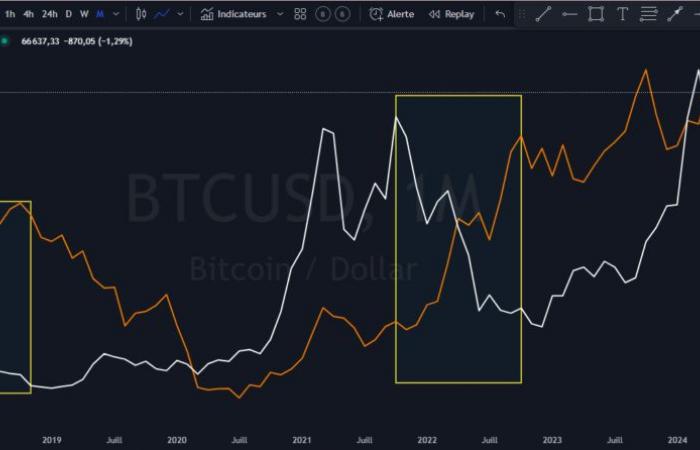9:00 a.m. ▪
8
min reading ▪ by
Laetitia B.
There has been a lot of volatility over the last two years in terms of interest rates. How can a change in the rate of return affect an asset like bitcoin? This is where we will see together the different factors surrounding the variation in rates as well as the consequences on bitcoin.
Why is the 10-year yield important?
The US 10-year yield rate is one of the most watched interest rates in the world. There are several factors that explain this. Initially, it is used as the least risky investment since the US Treasury is expected to repay the invested capital on the maturity date. The risk lies in the solvency of the country. Therefore, as it is considered low risk, it will often be compared to other asset classes. This is in order to know if the compensation will be profitable or not. So, the objective is to seek a return higher than “free risk” if we take an asset with more risk. Secondly, the 10-year yield rate will also play a role in relation to other debts. For example, it will affect the rates used for real estate loans or mortgage loans.
Factors that influence the 10-year rate of return
The variation in the 10-year rate of return (interest rate) can come from several reasons such as the evolution of growth, inflation, central bank decisions, supply and demand… As it evolves according to several factors , the impact on assets may differ sometimes. This is why it is important to know the underlying reason for the movement and the environment.
For example, the 10-year yield rate could rise because we are accelerating growth. And then, it could continue to rise because there is pressure on inflation which results from the acceleration of growth. In both cases, the interest rate rises but the impact on interest rate sensitive assets will be different. It’s all a question of balance against the inflation target rate.
Following the economic climate (inflation, growth), the decisions of central banks on the key rate will also influence the evolution of rates as well as supply and demand. For example, when the central bank raises rates to slow inflation, there comes a point where short-term rates will exceed long-term rates. The stage where it is restrictive. This will then encourage investors to favor short-term treasury bills over long-term bonds because the rate of return is better. And vice versa when the central bank decides to lower its rates, this can encourage investors to favor bonds since the yield curve should normalize (short-term rates lower than long-term rates).
Bitcoin is quite sensitive to changes in interest rates like many other assets. In the past, sometimes the rate of return goes up and so does bitcoin, just as sometimes the rate goes down and bitcoin goes up. And more rarely, it happens that rates fall and bitcoin does too. This can be confusing but this is where we need to determine the reason for the movement in the rate of return. We will take a few examples to make it easier to understand.
For example, if the 10-year yield rate rises because growth accelerates, the variation in bitcoin should be positive since investor confidence to invest is back. We can see this in the graph below after the low point of the Covid crisis. Rates are rising with bitcoin.
The other example below highlights the increase in the rate of return following an increase in the level of inflation. An increase in prices may be a late consequence of the acceleration of growth. In this type of situation, several risk assets including bitcoin find it more difficult because the rate rises to slow inflation while growth slows. In this type of climate, bitcoin is more fragile. heree graph of bitcoin and rate of return in this kind of environment.

There are several reasons that can explain this, particularly the case with weakening purchasing power. Investors are more skeptical about investing capital. On the other hand, as the cost of borrowing is higher, this limits the potential leverage used in business to grow. This is also the case for households who will borrow less to consume. This can have rapid impacts on more risk-sensitive assets such as small businesses or speculative assets. The investor will favor safe investments by favoring low-risk products such as treasury bonds.
Bitcoin, inflation and the rate of return
Bitcoin was strategically designed to address inflation through the expansion of the money supply. The halving process will reduce its inflation rate every 4 years. This dynamic allows bitcoin to be bullish in the long term as long as we continue to have growth in the money supply.
Despite the fact that its inflation rate is reduced every 4 years, it did not serve as a hedge against the strong surge in inflation which was accompanied by an increase in the rate of return in 2022. This is explained in particular by the fact that bitcoin is a performing asset when financial conditions are favorable. As central banks implemented a restrictive program through rate hikes, financial conditions became more difficult. The US dollar strengthened, rates rose and money supply growth declined. As a result, bitcoin fell.
Bitcoin tends to perform when financial conditions are more accommodating. Even if the FED kept rates high in 2023 (implying keeping the rate of return high), the process of disinflation, the FED pause as well as the decline of the dollar have made financial conditions more flexible. This also explains the economic rebound and that of bitcoin despite still high rates. This is why it is important to understand the economic environment to determine the variation of assets like bitcoin.
CONCLUSION
The interest rate or rate of return has a strong influence on many assets including bitcoin. Generally speaking, the lower the rates, the more it will encourage consumption and investment resulting in an increase in prices, which is positive for bitcoin in the long term.
Maximize your Cointribune experience with our ‘Read to Earn’ program! For every article you read, earn points and access exclusive rewards. Sign up now and start earning benefits.
Click here to join ‘Read to Earn’ and turn your passion for crypto into rewards!
Laetitia B.
After working for 7 years in a Canadian bank, including 5 years in a portfolio management team as an analyst, I left my position to devote myself fully to financial markets. My goal here is to democratize financial market information to the Cointribune audience on different aspects, including macro analysis, technical analysis, intermarket analysis, etc.







